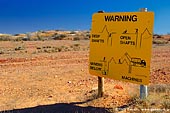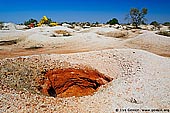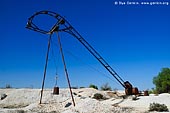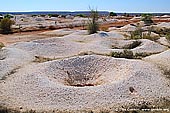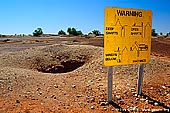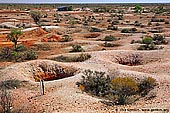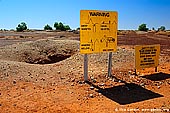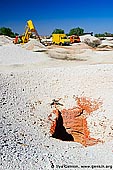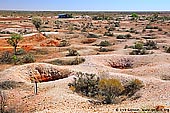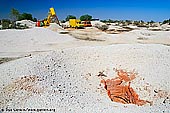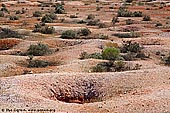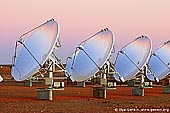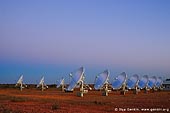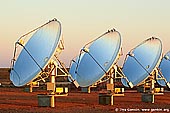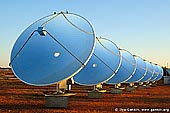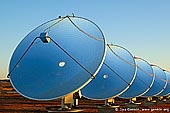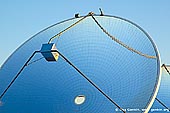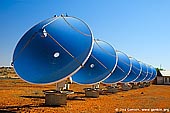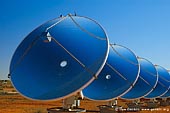White Cliffs Photos
Solar Power Station and Opal Mines , White Cliffs, New South Wales (NSW), Australia
White Cliffs is a small town in outback New South Wales in Australia, in Central Darling Shire. White Cliffs is around 255 km northeast of Broken Hill and about 100km northwest of Wilcannia. White Cliffs is a famous opal mining settlement founded over 100 yrs ago and also famous for its Solar Power Station - Australia's first solar power station.
The town was established in the late 19th century when opal was discovered. In 1889 four kangaroo shooters were hired to reduce kangaroo numbers on the Momba Station. The roo shooters found opals and realising their potential value sent them off to Adelaide for valuation. Within the year a small settlement had come into existence and White Cliffs opals were available on markets in Britain, the Continent and the USA. By 1897 White Cliffs had grown to a point where there were about 1000 people. At its height around 1898-1900, White Cliffs was home to an estimated 5000 people and in today's terms sold millions of dollars worth of opal. Building materials were scarce and expensive and the heat in summer was oppressive. And, around 1894, miners started converting their old shafts into homes. Today there are around 140 "dugouts" (underground homes), which are as comfortable and modern as houses in other towns. Right now White Cliffs population depends on seasons and is somewhere between 100 and 400. From the air, White Cliffs looks like a moonscape with an estimated 50,000 disused diggings which look like small craters. In 1987 the production of opals from the White Cliffs fields was estimated to be $150 million. Remarkable opals have been found, such as the White Cliffs opal "pineapples" and opalised shells. By far the most unusual was the opalised remains of a nearly 2 metre long plesiosaur, believed to be around 100 million years old.
White Cliffs was chosen for building the solar power station because of the highest insolation in New South Wales. In 1981 the solar power station was constructed by a team from Australian National University. At that time White Cliffs had no electrical grid connection and the station provided electricity to the town. The station consisted of fourteen three-metre parabolic dishes, each covered by more than 2000 mirrors and mounted on a heliostatic mounting. The dishes each focussed the sun's rays on a collector, where water was boiled. The resulting steam drove a steam engine, delivering up to 25kWe. In 1996, following grid connection of the township, the station was converted to photovoltaic. The dishes were resurfaced, and the original collectors each replaced by a cluster of 16 water-cooled photovoltaic cells. In its new form, the station delivers up to 45kWe. The steam engine, batteries, and diesel generator were removed, and the output fed into the grid. The grid connected power station ran for around 6 years, generating valuable data on the long-term performance and efficiency of the modules. The power station ceased operation in December 2004 and has been resumed by the owner of the site.
About the Artist
I'm Ilya Genkin - an internationally recognised Australian landscape and fine art photographer offering wall art prints. My passion for capturing the beauty of nature and our world translates into striking photographic prints that bring life, emotion, and inspiration to any space. From tranquil seascapes to dramatic mountainscapes, each image is a reflection of my vision and dedication to the art of photography.
Read more about Ilya Genkin and shop fine art prints online from his collection.
Wall Art Prints Featuring Fine Art Landscape Photography
Explore my extensive collection of wall art prints - crafted with the highest-quality materials to suit every style and budget. Whether you're looking for a luxurious, ready-to-hang piece or a beautifully printed work to frame yourself, each photograph is available in several premium formats: Gallery-quality Fine Art Paper Prints - ready for framing, and Professional Canvas Prints - classic and timeless texture.
Each artwork is meticulously printed and made-to-order to ensure you receive a piece that elevates your home, office, or commercial space. Buy fine art prints online to suit your style.
Artworks for Interior Designers, Home Stylists, and Architects
I collaborate with interior designers, home stylists, and architects to create bespoke wall art prints tailored to your project's aesthetic, colour palette and interior design needs. Prints can be customised and sized to complement your space perfectly. All pieces are made-to-order, and pricing varies based on size, quantity, and shipping.
Contact me to discuss your project and request a personalised quote.
Why Choose Ilya Genkin Photography?
By choosing my work, you're not just acquiring exceptional art - you're supporting an independent Australian artist and contributing to a vibrant local creative community. Every purchase directly helps sustain and grow this craft, bringing authentic and meaningful art into your life.
Request a free mockup to see how a chosen photograph will look in your space before you buy.
Start your journey today - shop our wall art collection, purchase with confidence, or order custom prints today and transform your walls with fine art photography.
Fine Art Landscape Photography
Information
Photography Guides
Online Store Opens 24/7
Email:
Phone: +61 (0) 421 055 613
Crafted with care for the planet - using sustainable materials and eco-friendly packaging.
Ilya Genkin Photography acknowledges the Traditional Custodians of the land on which we operate, live and gather as employees, and recognise their continuing connection to land, water and community. We pay respect to Elders past, present and emerging.
